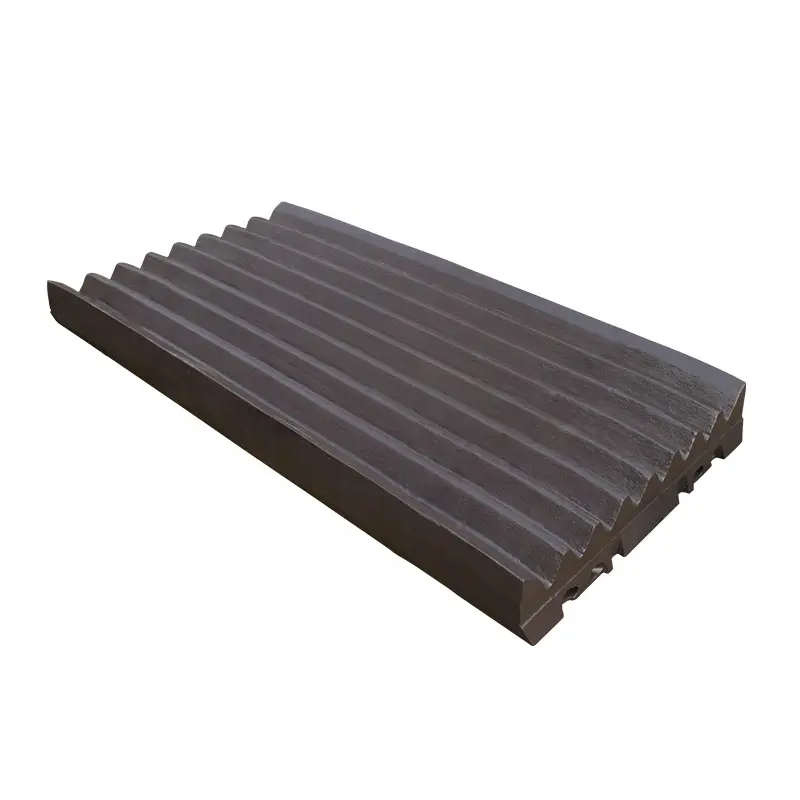What influence does the design of the cheek plate of the jaw crusher have on its wear resistance?
The cheek plate of the jaw crusher is one of the key components of the crusher, and its wear resistance directly affects the service life and production efficiency of the equipment. This article will explore how the design of the cheek plate of the jaw crusher affects its wear resistance, including aspects such as material selection, heat treatment process, and structural design.
First, the influence of material selection on wear resistance
(1) High manganese steel
High manganese steel is the traditional material for the cheek plates of jaw crushers, featuring excellent toughness and deformation hardening ability. However, the surface hardness of high manganese steel is relatively low, and its wear resistance is poor. During operation, the cheek plate wears out relatively quickly. To enhance the wear resistance of high manganese steel cheek plates, the following methods can be adopted:
Alloying: Adding an appropriate amount of alloying elements, such as chromium (Cr) and molybdenum (Mo), to high manganese steel can enhance its hardness and wear resistance.
Surface treatment: Through surface hardening treatments such as carburizing and nitriding, the hardness and wear resistance of the cheek plate surface can be enhanced.
(2) Medium carbon low alloy steel
Medium carbon low alloy steel is obtained by adding multiple alloying elements (such as Cr, Si, Mn, Mo, V) to medium carbon steel, with a total alloy content of less than 5%. This material can achieve different mechanical properties by adjusting the carbon content and the content of alloying elements and matching different heat treatment processes, thereby enhancing its wear resistance.
(3) High-chromium cast iron
High-chromium cast iron has high hardness and wear resistance, and is suitable for crushing materials with high hardness. However, its toughness is relatively low and it is prone to fracture under high impact loads.
Second, the influence of heat treatment processes on wear resistance
(1) Quenching and tempering
Quenching can significantly increase the hardness of materials, but it will reduce their toughness. Therefore, tempering is usually required to adjust the balance between the hardness and toughness of the material. For instance, after quenching and tempering treatment, ZG42Mn2Si1REB steel can achieve high hardness and good wear resistance.
(2) Surface hardening treatment
Surface hardening treatments, such as carburizing, nitriding, and carbo-nitriding, can significantly enhance surface hardness and wear resistance without altering the internal properties of the material.
Third, the influence of structural design on wear resistance
(1) Tooth profile design
The tooth profile design of the buccal plate has an important influence on its wear resistance. A reasonable tooth profile design can reduce the contact area between the material and the cheek plate and lower the wear rate. For instance, pitch and tooth height are key factors influencing wear resistance. Appropriate pitch and height can enhance the crushing efficiency and reduce the wear of the cheek plate at the same time.
(2) Thickness of the liner
The thickness of the liner also affects its wear resistance. Thicker liners can provide more wear-resistant materials and extend the service life. However, overly thick liners may increase the weight and cost of the equipment.
(3) Installation and fixation
The installation and fixation methods of the cheek plate also have an impact on its wear resistance. If the cheek plate is not installed firmly, it may become loose during operation, leading to accelerated wear. Therefore, during installation, it is necessary to ensure that the cheek plate makes smooth contact with the machine surface and to use an appropriate fixing method.
Fourth, measures to enhance wear resistance in practical applications
(1) Regular inspection and maintenance
Regularly check the wear and tear of the buccal plate and promptly repair or replace the severely worn parts. For instance, for worn and failed cheek plates, they can be repaired by surfacing welding or arc welding.
(2) Control the feed particle size
Control the feed particle size within 85% of the maximum feed port size of the jaw crusher to avoid damage or excessive wear of the cheek plate caused by overly large stones.
(3) Random inspection of materials
Random checks are conducted on the materials entering the crusher to ensure that the properties of the materials meet the crushing requirements. If the hardness or mud content of the material is found to be too high, the parameters of the crusher should be adjusted in time.
The design of the cheek plate of the jaw crusher has a significant influence on its wear resistance. By choosing appropriate materials, optimizing heat treatment processes and reasonable structural designs, the wear resistance of the cheek plate can be significantly improved and its service life can be prolonged. In practical applications, measures such as regular inspection and maintenance, control of feed particle size, and random inspection of materials can also effectively reduce the wear of cheek plates, improve production efficiency and economic benefits.
It is hoped that the above content can help you better understand the influence of the design of the cheek plate of the jaw crusher on wear resistance. If you have any questions about the cheek plate of the jaw crusher or need further information, please feel free to contact us at any time.




